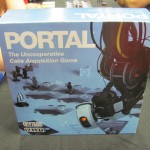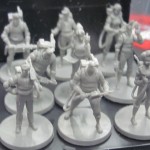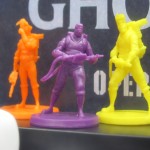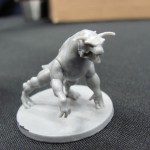Second Look—Portal: The Uncooperative Cake Acquisition Game
23 Sep
Posted by Thomas Deeny as Modern Board Games
 The computer game Portal is an interesting puzzle game with the player using a portal gun—a device that creates wormholes on walls—to navigate through a (usually) trap-filled testing chamber controlled by a demented AI who promises cake at the end. Portal is one of Valve’s award-winning games and a flagship product on the Steam gaming service. In 2012, the computer game company began to develop a tabletop game based on Portal, eventually teaming up with Cryptozoic Entertainment in 2013 to continue development of the game. Now available for pre-order, we’ve had a chance to play the game.
The computer game Portal is an interesting puzzle game with the player using a portal gun—a device that creates wormholes on walls—to navigate through a (usually) trap-filled testing chamber controlled by a demented AI who promises cake at the end. Portal is one of Valve’s award-winning games and a flagship product on the Steam gaming service. In 2012, the computer game company began to develop a tabletop game based on Portal, eventually teaming up with Cryptozoic Entertainment in 2013 to continue development of the game. Now available for pre-order, we’ve had a chance to play the game.
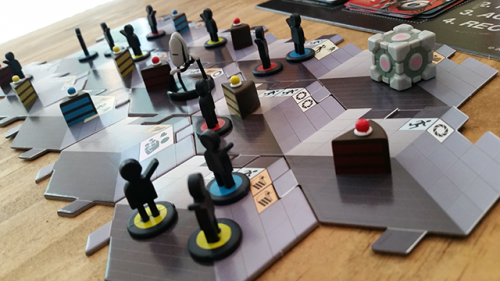
Portal: The Uncooperative Cake Acquisition Game is a game for 2-4 players, each heading up a team of test subjects. Three rows of hexagon-shaped test chambers are connected to form the board (the “laboratory”). Each turn, GLADoS (the active player) removes a test chamber from one edge of the board, and places it at the other end. The effect is an infinite board, much like Thunder Road. When a test chamber is removed, whichever player has a majority of test subjects on that tile gains the rewards listed on the tile which might be the ability to move a gun turret, adding one or more test subjects to the laboratory, or slices of cake. All test subjects are removed from that tile, so you’re sacrificing test subjects to possibly gain a reward. If there is any cake on that tile, it is incinerated. As soon as one player has no test subjects on the board, the game ends. The winner is the player with the largest number of cake slices in the laboratory.
The cards in Portal have “play now” abilities on the front (“Aerial Faith Plate: Move one test subject of any color to an adjacent chamber”), and characters with abilities to be used by all on the back (“Cave Johnson: To earn cake from an activated chamber, all test subjects in that chamber must be the same color.”). Play that card and it sits on top of the discard pile with a character from the game and a rule that stays in play until that character is covered up. So: how to best play the two cards in my hand to not give the other players a powerful ability they can use right away?
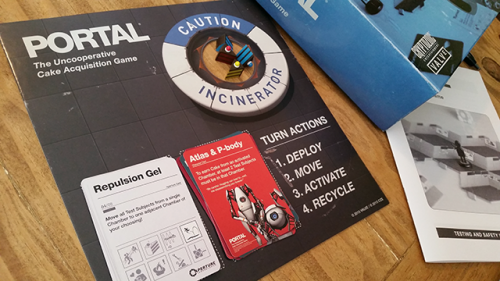
The game is all about positioning: With only three test subjects on the board, can I maneuver them to a position where they will be picked by GLADoS? Should I have a test subject pick up my opponent’s cake slice and merrily run a tile that will be incinerated or should I pick up one of mine and move it to a safer room? That’s where the puzzle of this game comes in: positioning and moving your test subjects around.
I can see a bit of analysis paralysis creeping up in this game. Even with a small number of test subjects for a player to manipulate, the player can only choose one chamber’s test subjects to move. Take Ticket to Ride as a counterexample: TTR has only a few things a player can do on your turn, just like Portal does. However, Portal has the chance to trigger AP in some players due to the size of the board and the immediacy of GLADoS removing test chambers.
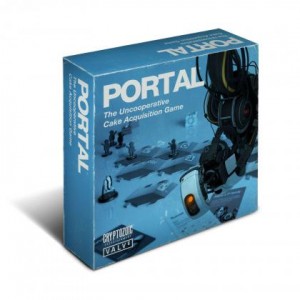 Speaking of GLADoS, there’s a standee counter for it which you’re supposed to use to indicate which chamber is being removed, but in practice it’s completely useless. Also speaking of completely useless: throw away the insert. The insert is usable as long as you don’t actually remove anything from the punchboards: no place to store the useless GLADoS standee, the cake pieces, the test subjects, or the portal markers. (We’re talking the Asmodee edition of Mission: Red Planet bad.) Cool companion cube and turret figures for the game (even if one of the panels on the turret seems to have arrived broken).
Speaking of GLADoS, there’s a standee counter for it which you’re supposed to use to indicate which chamber is being removed, but in practice it’s completely useless. Also speaking of completely useless: throw away the insert. The insert is usable as long as you don’t actually remove anything from the punchboards: no place to store the useless GLADoS standee, the cake pieces, the test subjects, or the portal markers. (We’re talking the Asmodee edition of Mission: Red Planet bad.) Cool companion cube and turret figures for the game (even if one of the panels on the turret seems to have arrived broken).
Our two-player games were around twenty minutes long. We’re going to give this a spin with three players later this week.
The game itself is fun and filled with a lot of short-term strategy decisions. I was going to recommend it, but… the MSRP is $50. Quite frankly, it doesn’t feel like similar games at that price point. The packaging has a bit to blame for this: the box has faux-aging on it, like it’s been beaten up a bit and well-loved/used over the years. The back of the box features a bland photo one might see on a family boardgame from the early 1970s. While it all fits to recall the computer game, the boardgame’s exterior has that look from a time before games cost $50; the physical design of the game says “cheap”.
I’m also irrationally upset with that insert.
But that’s balanced by the gameplay. We found it fun. Gameplay is also strategic (which I really enjoy). And the game does come with a Steam code for Portal 2, so…consider this a $40 game with a $10 computer game bundle, I suppose.
A copy of Portal: The Uncooperative Cake Acquisition Game was provided free for review by Cryptozoic Entertainment
- Comments Off on Second Look—Portal: The Uncooperative Cake Acquisition Game
Gen Con 2015—Portal, Ghostbusters, and DC Comics from Cryptozoic
06 Aug
Posted by David Miller as Card Games, Modern Board Games
 Recently released by Cryptozoic for its DC Comics Deck Building Game were Arrow and Justice Society of America Crossover Packs. These are $10 mini-expansions with 20-30 cards each. Next up in the series will be a Legion of Superheroes Crossover Pack in October for the same $10. And then later in the fourth quarter, or possibly the first quarter of 2016, will be a Watchmen Crossover Pack. This one will feature new modes of play, including individual hidden agendas and a traitor mechanic, retailing for $13.
Recently released by Cryptozoic for its DC Comics Deck Building Game were Arrow and Justice Society of America Crossover Packs. These are $10 mini-expansions with 20-30 cards each. Next up in the series will be a Legion of Superheroes Crossover Pack in October for the same $10. And then later in the fourth quarter, or possibly the first quarter of 2016, will be a Watchmen Crossover Pack. This one will feature new modes of play, including individual hidden agendas and a traitor mechanic, retailing for $13.
Being demoed at Gen Con were two highly anticipated licensed board games, Portal and Ghostbusters.
The Portal Board Game is due in September for a retail price of $50. Not so much a reproduction of the video game experience as evocative of it, the cardboard version has players moving their test subjects through the game to earn cake. Included in the box is a Steam code for a free copy of Portal 2. And speaking of the box, it comes with this cool incinerator insert for dropping in pieces of cake.
For the Ghostbusters Board Game scheduled to ship in October at a retail price of $85, Cryptozoic had final production figures on display.
UPDATE: Somehow I forgot to mention the Portal incinerator and missed the pictures I had of it and the box.
- Comments Off on Gen Con 2015—Portal, Ghostbusters, and DC Comics from Cryptozoic
Trending
- Massdrop.com
- Oh the Irony—Illuminati Card Game Continues to Inspire Conspiracy Theorists
- Footprints, an Educational Ecology Game
- USPS Adds Board Game Flat Rate Box
- Home
- Baila, the Estonian Drinking Card Game
- Crystal Caste Wins Dice Patent Suit Against Hasbro
- Mirror Game, Red and Blue
- Hasbro and Mattel Merger?
- Are Board Games Dangerous?
Archives
Most Popular Articles
- Oh the Irony—Illuminati Card Game Continues to Inspire Conspiracy Theorists
- The 20 Most Valuable Vintage Board Games
- The Truth About Dominoes On Sunday in Alabama
- Sequence Game, and Variants
- USPS Adds Board Game Flat Rate Box
- Baila, the Estonian Drinking Card Game
- The 13 Most Popular Dice Games
- Are Board Games Dangerous?
- Guess Who? The Naked Version
- What Happened to the Jewel Royale Chess Set?
Recent Posts
- Toy Fair 2019—Breaking Games
- Talisman Kingdom Hearts Edition
- Toy Fair 2019—Winning Moves
- Toy Fair 2019—Games Workshop
- Toy Fair 2019—Star Wars Lightsaber Academy
- Toy Fair 2019—Stranger Things Games
- Toy Fair 2019—HABA
- Licensing Roundup
- Game Bandit
- 2018 A Difficult Year For Hasbro But Not For D&D Or MtG
Recent Comments
- on Toy Fair 2019—Winning Moves
- on Game Bandit
- on Second Look—Dungeons & Dragons Waterdeep Dragon Heist
- on Crowdfunding Highlights
- on Beyblade SlingShock
- on Game Bandit
- on Game Bandit
- on Watch This Game!, the Board Game Review Board Game
- on Second Look—Vampire: The Masquerade 5th Edition
- on Palladium Books Loses Robotech IP License, Cancels Five-Year-Overdue Robotech RPG Tactics Kickstarter

